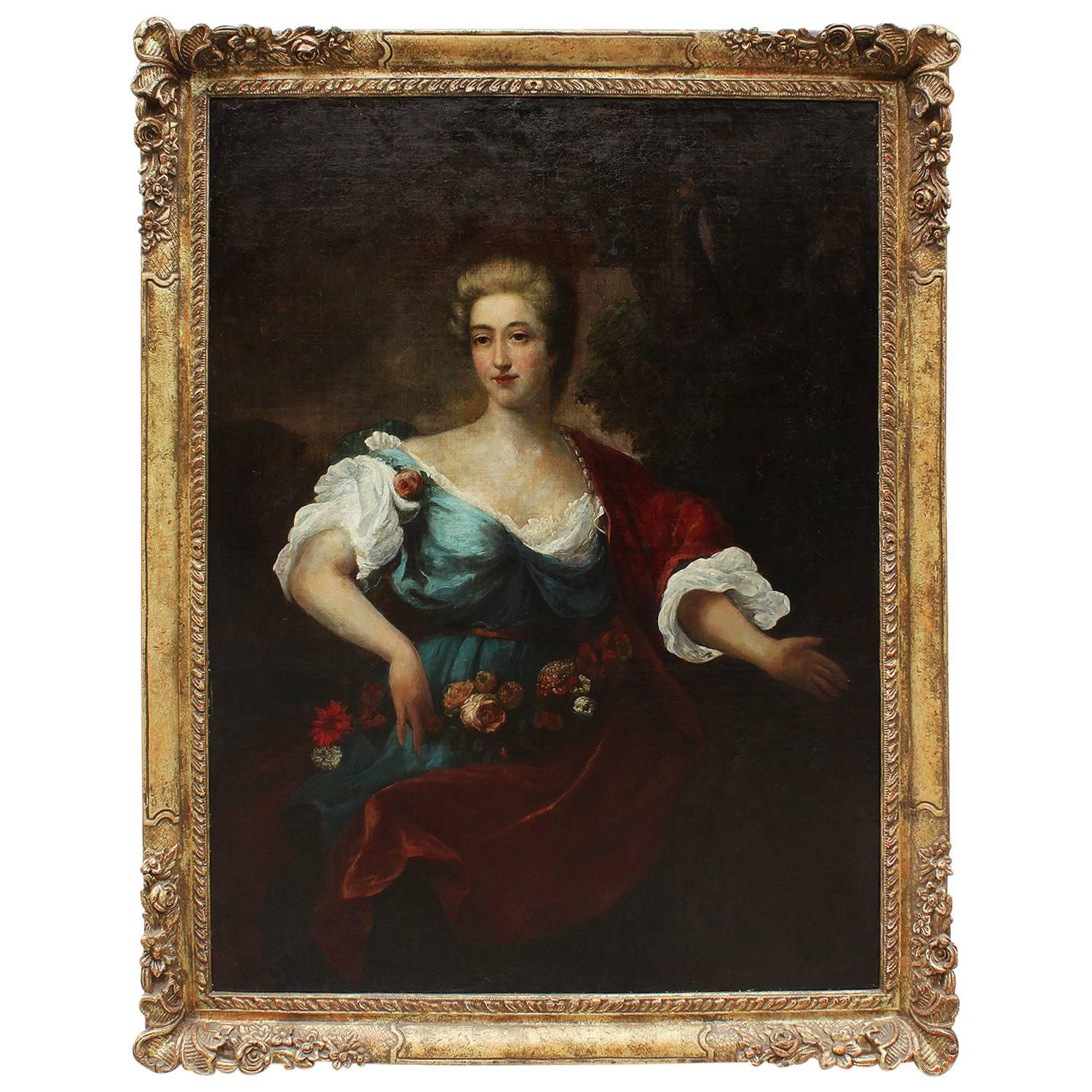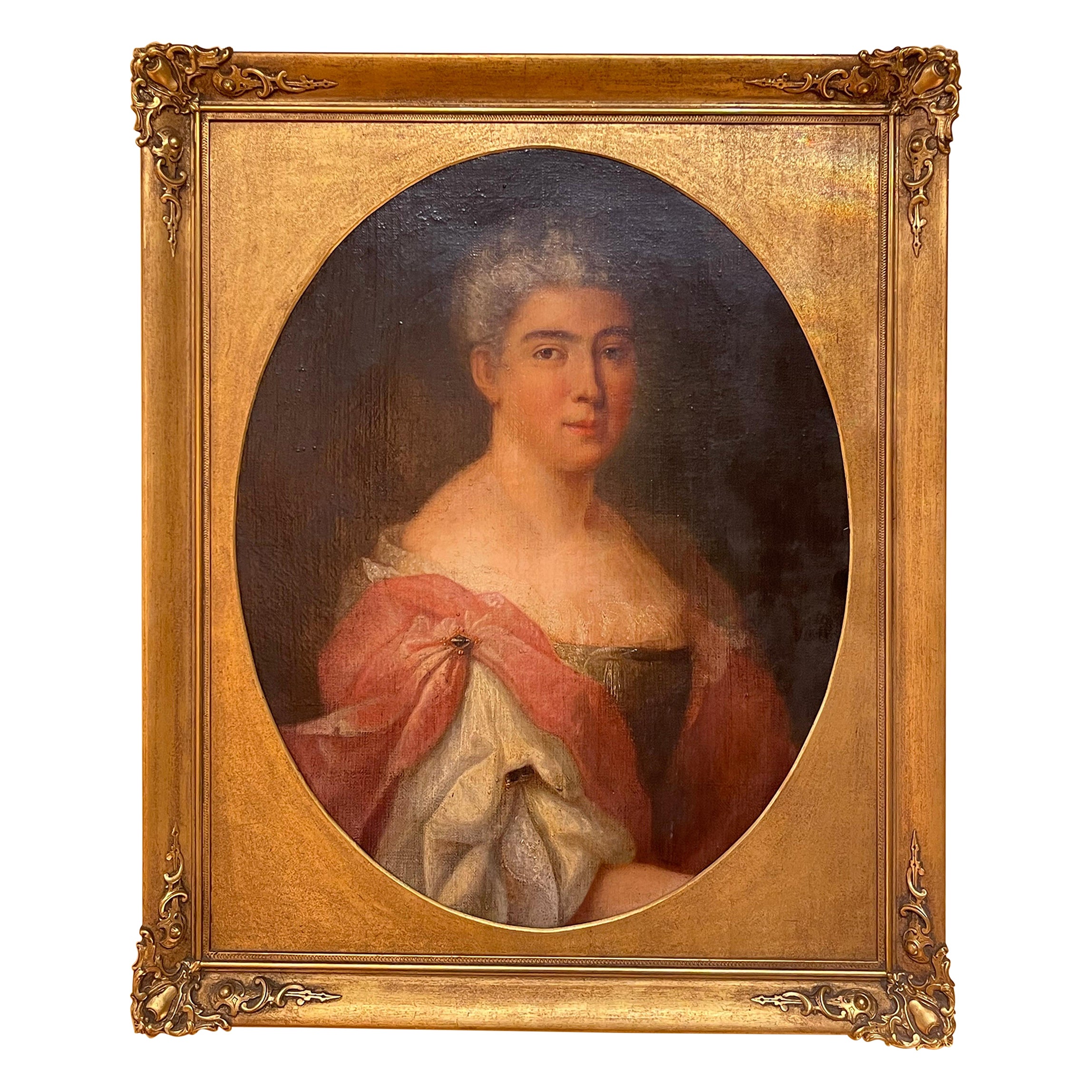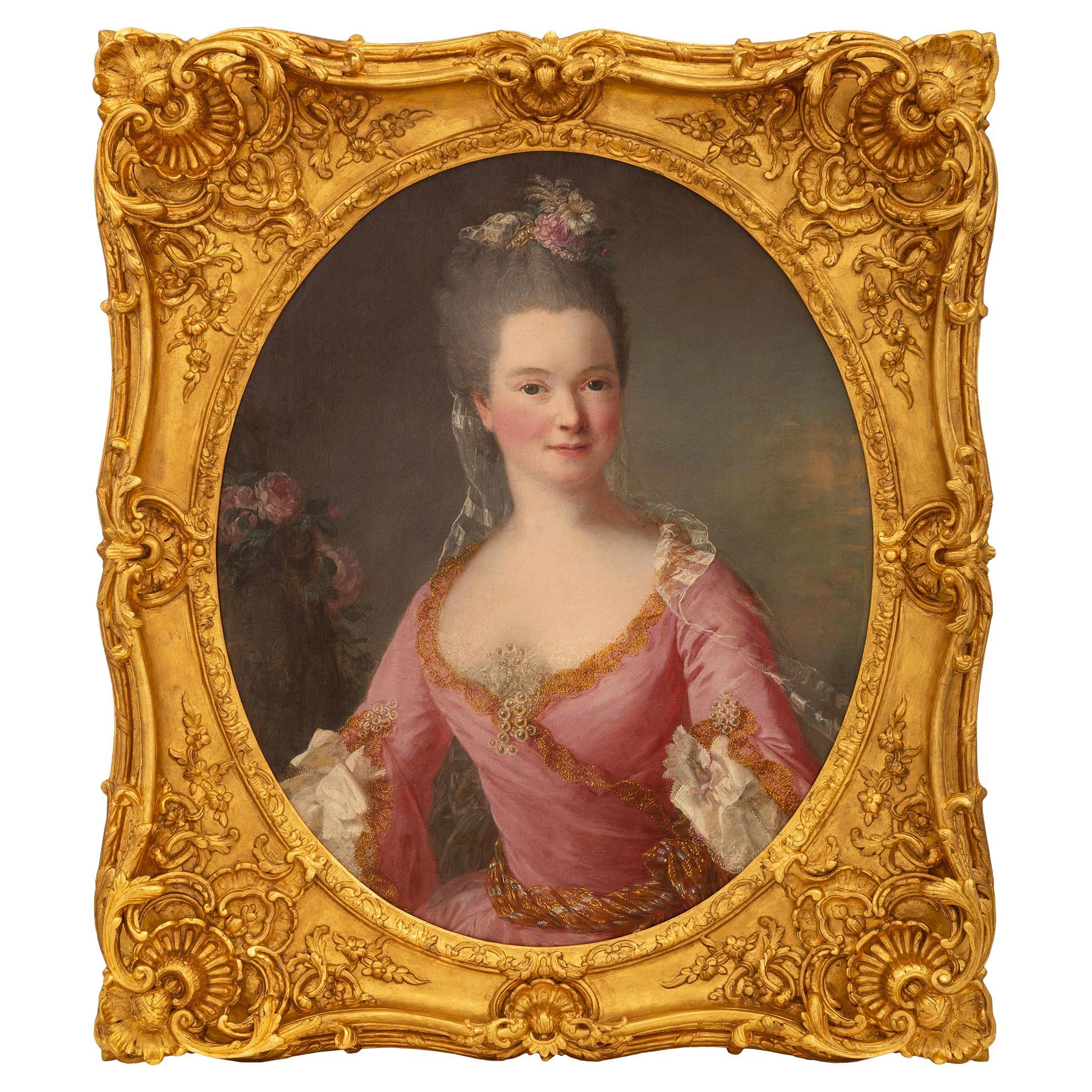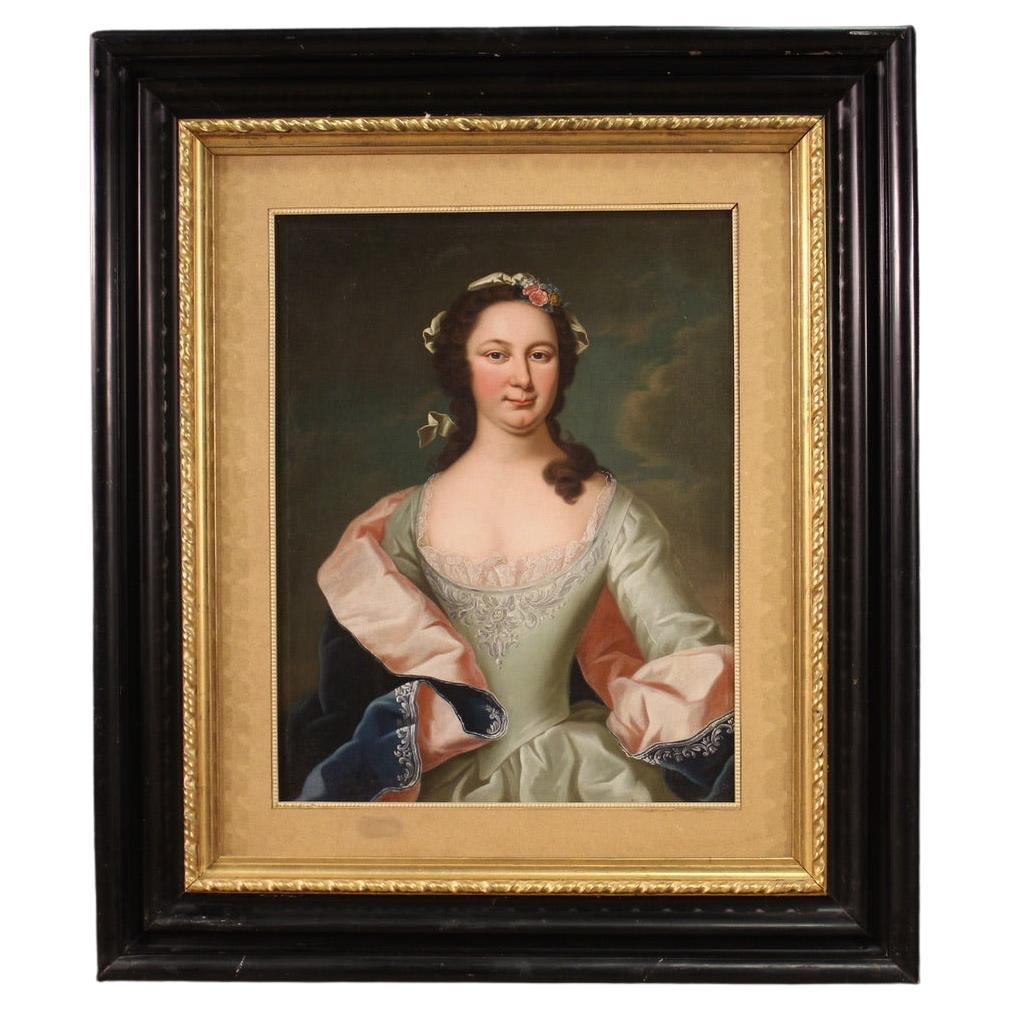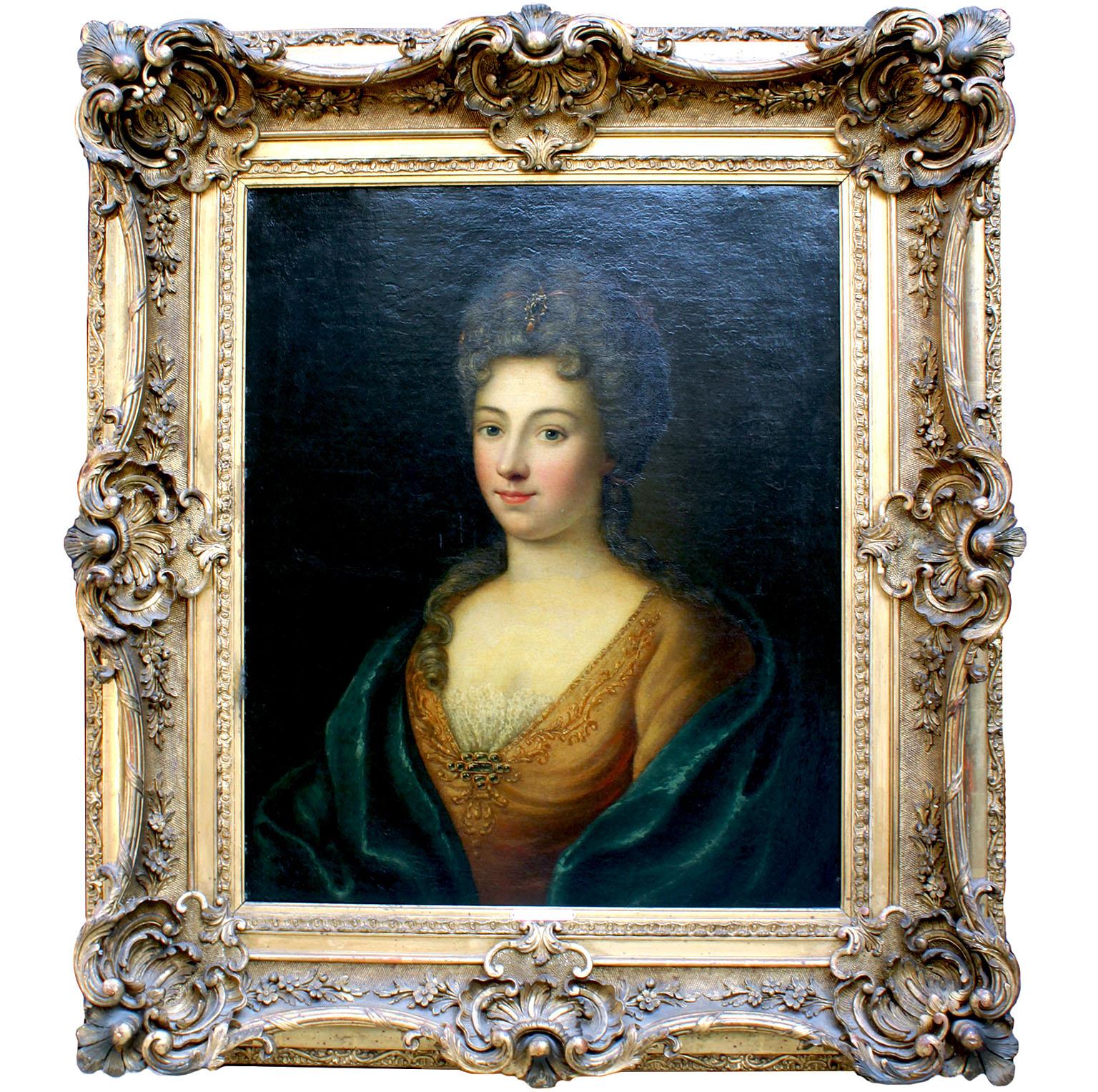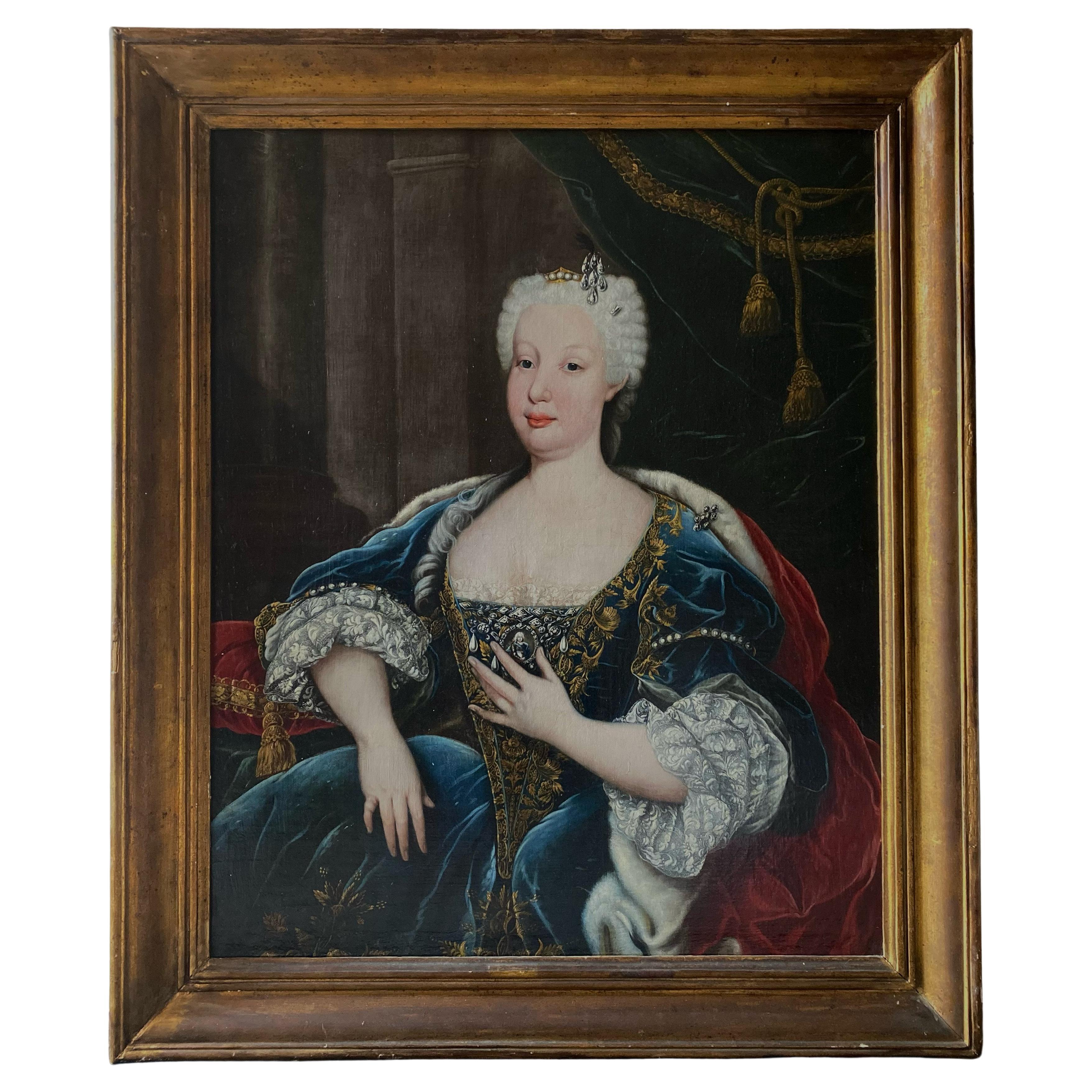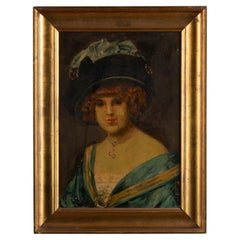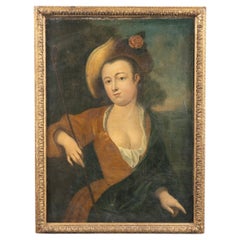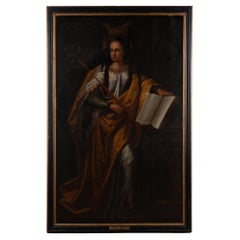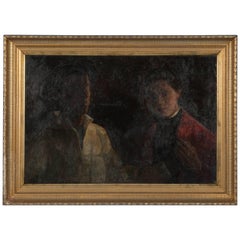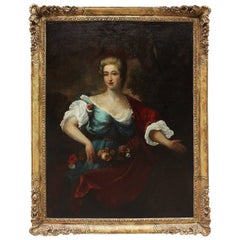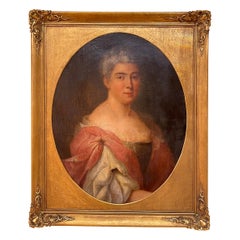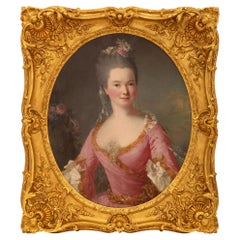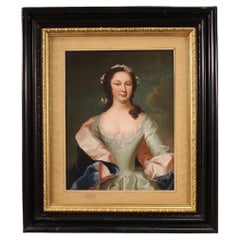Items Similar to Original Oil on Canvas Portrait of Marquise de Broglie, France circa 1925
Want more images or videos?
Request additional images or videos from the seller
1 of 13
Original Oil on Canvas Portrait of Marquise de Broglie, France circa 1925
$4,650
£3,530.86
€4,037.80
CA$6,496.72
A$7,225.78
CHF 3,773.08
MX$87,930
NOK 48,187.93
SEK 45,191.78
DKK 30,135.62
Shipping
Retrieving quote...The 1stDibs Promise:
Authenticity Guarantee,
Money-Back Guarantee,
24-Hour Cancellation
About the Item
An original oil on canvas portrait of Marquise de Broglie (1718-1777). The original portrait by Jean Marc Nattier (1685-1766) hangs in the National Museum in Stockholm, while this reproduction was painted by Albert Zetterberg, 1925.
This beautiful rendition of the Marquise de Broglie as Sultana has vibrant colors. Canvas shows typical age related wear and may benefit from a light cleaning which we leave to the discretion of the buyer. Frame is in good condition, may have minor paint loss/chips or cracks which is a reflection of age and use as well.
Please enlarge photos for clear understanding of color, condition and details.
With over 37 years of experience selling European antiques, our brick-and-mortar storefront, Round Top Ranch Antiques (located in Texas) offers one of the largest curated selections in the nation with over thirty-five thousand square feet of inventory to choose from. We look forward to helping you find the perfect addition to your home or workspace. Thank you for visiting our online store!
- Dimensions:Height: 35.75 in (90.81 cm)Width: 29.25 in (74.3 cm)Depth: 3 in (7.62 cm)
- Materials and Techniques:
- Place of Origin:
- Period:
- Date of Manufacture:Circa 1925
- Condition:Wear consistent with age and use. Canvas shows typical age related wear. Frame is in good condition, may have minor paint loss/chips or cracks which is a reflection of age and use as well.
- Seller Location:Round Top, TX
- Reference Number:Seller: 250161stDibs: LU923635549322
About the Seller
5.0
Platinum Seller
Premium sellers with a 4.7+ rating and 24-hour response times
Established in 1995
1stDibs seller since 2012
638 sales on 1stDibs
Typical response time: 1 hour
- ShippingRetrieving quote...Shipping from: Round Top, TX
- Return Policy
Authenticity Guarantee
In the unlikely event there’s an issue with an item’s authenticity, contact us within 1 year for a full refund. DetailsMoney-Back Guarantee
If your item is not as described, is damaged in transit, or does not arrive, contact us within 7 days for a full refund. Details24-Hour Cancellation
You have a 24-hour grace period in which to reconsider your purchase, with no questions asked.Vetted Professional Sellers
Our world-class sellers must adhere to strict standards for service and quality, maintaining the integrity of our listings.Price-Match Guarantee
If you find that a seller listed the same item for a lower price elsewhere, we’ll match it.Trusted Global Delivery
Our best-in-class carrier network provides specialized shipping options worldwide, including custom delivery.More From This Seller
View All19th Century Original Oil on Canvas Portrait of Woman, "Edith" Signed A. Weie
Located in Round Top, TX
Original oil on canvas portrait of the Danish Painter Holger Drachmann's lover and muse, Amanda Jensine Nielsen the singer. Signed A. Weie on the reverse. Oil on canvas.
Craquelure...
Category
Antique Late 19th Century English Paintings
Materials
Canvas, Wood, Paint
Original Oil on Canvas Portrait of Lady With Riding Crop, Sweden circa 1700's
Located in Round Top, TX
Original oil on canvas portrait of a lady with hat and riding crop.
Unknown artist, circa 1700's.
Major wear, craquelure throughout. Stains, paint loss, scratches.
Typical age relate...
Category
Antique Early 18th Century Swedish Paintings
Materials
Canvas, Wood, Paint
18th Century Large Oil on Canvas Italian Painting of King's Daughter, "Europe"
Located in Round Top, TX
Large Original oil on canvas painting of a scene with the king's daughter “Europe”. Unsigned. Inscribed S. Evropæa.
Italian painter, circa late 1700:'s. This painting stands over 6' ...
Category
Antique Late 18th Century Italian Paintings
Materials
Canvas, Wood, Paint
Antique 19th Century Original Oil Painting Portrait by Sigurd Wandel
Located in Round Top, TX
Original oil on canvas portrait of a mother and son by Sigurd Wandel (1875-1943). The painting is mounted in a giltwood and gesso frame and penciled on the back stretcher, mother and...
Category
Early 20th Century Danish Paintings
Materials
Giltwood
18th Century French Original Oil on Canvas Painting of Aging King
Located in Round Top, TX
Original oil on canvas painting of Biblical or historical motif with what appears to be an aging king surrounded by attendants.
Unknown artist, no signature.
Old label on back of pa...
Category
Antique Mid-18th Century French Paintings
Materials
Canvas, Wood, Paint
Early 18th Century Oil on Canvas Laid on Board Painting, Italian School
Located in Round Top, TX
Original oil on canvas laid on panel painting, Italian school. Unsigned. Possibly a religious composition with three putti in lower left.
Condition: Age related craquelure, some abra...
Category
Antique Early 18th Century Italian Paintings
Materials
Canvas, Wood, Paint
You May Also Like
French 18th-19th Century Oil on Canvas Portrait of Lady, after Jean-Marc Nattier
By Jean-Marc Nattier
Located in Los Angeles, CA
A very fine French 18th-19th century oil on canvas portrait of a posing lady with flowers, after Jean-Marc Nattier (1685-1766) within an ornate gilt wood carved frame, circa 1800.
...
Category
Antique Early 19th Century French Louis XV Paintings
Materials
Canvas, Giltwood
$11,960 Sale Price
20% Off
Antique Portrait / Oil Painting of a Noblewoman, France 18th Century
Located in Berlin, DE
Antique portrait / oil painting of a noblewoman, France 18th Century
Painting painted oil on canvas, oval stretcher. Portrait of an eagle lady, probably ...
Category
Antique 18th Century French Paintings
Materials
Canvas
Continental Early 19th Century Louis XV St. Oil on Canvas Portrait
Located in West Palm Beach, FL
A stunning and extremely high quality Continental early 19th century Louis XV st. oil on canvas portrait. The painting depicts a beautiful young maiden dressed in a most elegant pink...
Category
Antique 19th Century Unknown Louis XV Paintings
Materials
Canvas, Giltwood
19th Century Oil on Canvas Antique Austrian Painting Lady Portrait, circa 1870
Located in Vicoforte, Piedmont
Antique 19th century Austrian painting. Oil on canvas artwork depicting a female portrait, a young noblewoman in a pose of good pictorial quality. Pai...
Category
Antique Late 19th Century Austrian Paintings
Materials
Canvas
$6,230 Sale Price
20% Off
Free Shipping
Franco-German 19th Century Oil on Canvas "Portrait of a Lady" in Giltwood Frame
Located in Los Angeles, CA
A fine Franco-German 19th century oil on canvas "Portrait of a Lady" depicting an 18th century young beauty posing with a profile gaze and cur...
Category
Antique 19th Century French Louis XV Paintings
Materials
Gesso, Canvas, Wood
$9,850 Sale Price
33% Off
Portrait of D. Maria Bárbara De Bragança, Circle of Louis-Michel Van Loo
By H. van Loon
Located in Lisboa, PT
PORTRAIT OF D. MARIA BÁRBARA DE BRAGANÇA (1711-1758), QUEEN OF SPAIN
Circle of Louis-Michel van Loo (1707-1771)
Oil on canvas
Her Royal Highness, the Infanta Maria Barbara of Braganza (1711-1758) was the first-born child of King John V of Portugal (1689-1750) and his queen consort Maria Anna of Austria (1683-1754). Born in December 1711, she had the Convent Palace of Mafra built in her honour following a vow made by her royal father. Her status as Princess of Brazil, inherent to 18th century Portuguese presumptive heirs, would however be superseded once the queen gave birth to two male princes, D. Pedro (1712-1714) and D. José (1714-1777), preventing her from ascending to the throne.
Daughter of one of the most illustrious monarchs of his time, Maria Barbara was carefully educated to become a fond admirer of the arts, and of music in particular, having had the Italian composer Domenico Scarlatti (1685-1757) as her music teacher.
On the 10th January 1723 the young princess was betrothed to the Infante Ferdinand of Spain (1713-1759), eldest son of King Philip V (1683-1746). Six years later, on the 19th January, she entered her new country in a carefully choreographed ceremony that became known to history as the “Exchange of the Princesses”. This unique event took place on a specially built Bridge-Palace, a wooden, luxuriously decorated structure that included various modules and rooms, on both banks of the river Caia, the natural border between the town of Elvas in Portugal and of Badajoz in Spain. Simultaneously, on the same day that the Portuguese Infanta crossed the border to marry the Spanish Crown Prince, her new sister in law, the Infanta Mariana Victoria of Bourbon (1718-1781), her husband’s sister, crossed the same bridge in the opposite direction to marry Prince D. José, the Portuguese heir to the throne.
Once married, Maria Barbara would spend 17 years as Princess of Asturias, only becoming Queen of Spain at her husband’s accession following the death of Philip V in 1746. She is portrayed in the 1743 painting by Louis-Michel van Loo (1707-1771) now in the Prado Museum, in which Philip V had himself represented with all his close family.
The new Queen would take an important role at court eventually becoming the liaison between her husband and the King of Portugal, particularly throughout the negotiations for the Treaty of Madrid (1746-1750). Maintaining her interest in music, she patronized the Italian castrato singer Farinelli (1705-1782) while remaining close to her old master Scarlatti, having herself composed some sonatas for a large orchestra. She would also commission and fund the building of the Royal Salesians Monastery complex in central Madrid, where both her and Ferdinand VI are buried.
The portrait we are presenting for sale shows the Queen in half-length, turning left at three quarters. She is wearing a blue low-cut dress embroidered with flowers and foliage, over a lace cuffed white blouse, and an ermine cloak pined on the left-hand side by a diamond broach. The powdered hair style is held sideways by a seven diamond and black plume headdress and topped by a small gold and pearl crown. The right arm rests on a cushion while the left hand, at chest height, holds a miniature male portrait.
The Infanta’s features are analogous to the 1725 portrait by the painter Domenico Duprà (1689-1770), also in the Prado Museum collection. Further similarities can be found in another portrait by Louis-Michel van Loo, in which a seven diamond and black plume headdress is also present. In this work, the cushion supporting Maria Barbara’s right arm has also some obvious similarities to our painting. The same diamond headdress reappears in Van Loo’s above-mentioned portrait of Philip V’s family dated from 1743.
It is nevertheless in Lisbon’s Ajuda National Palace that it is possible to find an almost identical depiction of the Infanta holding a miniature portrait of her husband. In it, the future Ferdinand VI is portrayed facing right at three quarters and wearing a curly wig, suit of armour, the golden fleece insignia and a blue band, in a composition that closely resembles an 18th century Spanish school painting that appeared in the art market in January 2016.
Another detail common to various portraits of the Portuguese Infanta and Queen of Spain is the small gold and pearl crown on her head. In another Van Loo painting, also from the Prado Museum, in which Maria Barbara is portrayed as Queen, this crown is represented together with a headdress similar to the one previously described. Another two paintings by the same artist, at the Royal Academy of Saint Ferdinand, include the same ornament.
We must also refer the paintings by the artist Jean Ranc (1674-1735). In one, dating from 1729 (Prado Museum), the Infanta is depicted outdoors holding a flower bouquet and wearing a yellow silk dress with red cloak, and a set of diamond and ruby jewellery that includes a headdress similar to the one present in our portrait. Another work by the same artist, belonging to the Complutence University of Madrid, depicts the Infanta sumptuously dressed in identical colours to our painting and wearing an elaborate headdress and diadem.
These portraits, beyond their iconographical importance as contemporary records of the Infanta and Queen Maria Barbara, are also illustrative of 18th century fashion for jewelled head dressing. Often, flowers were combined with joyful adornments, composing almost theatrical displays that would reinforce the ostentatious nature of the image. The ornamental flowers and the chromatic character of the jewels would complement the luxury of the colourful dresses in blue, crimson, green or other silk shades, in compositions whose sole purpose was to highlight a royal sitter’s wealth and power, becoming an essential statement accessory within the strict court protocols and codes of conduct.
Circle of Louis-Michel van Loo (1707-1771)
Slowly but steadily, the resolute, tranquil and dignified attitude of Renaissance and Baroque portraiture becomes artificial and presumptuous. Mid 18th century society favours elusive expression and psychological deepness, albeit limited to the face, that, with emphasis on detail, on the rich colour palette and on changing costumes and landscapes, associated to the courtliness of gestures, creates a strongly artificial environment while maintaining a highly poetic intrinsic character.
Louis-Michel van Loo followed a dynasty of famous Dutch origin artists that had settled in France. Initially taught by his father, Jean-Baptiste von Loo (1684-1745), the younger van Loo studied in Turin and Rome and frequented the Paris Academy. In Rome he worked with his uncle Charles-André van Loo (1705-1765) and become a painter for the Turin Court. In 1737 he arrived in Spain being summoned by Philip V to succeed Jean Ranc as painter of the king’s chamber.
In Madrid, his work covers the numerous Court commissions and the Royal Saint Ferdinand Fine Arts Academy, of which he was a founding member and director for the Painting department in 1752. Is production at court consisted essentially of numerous portrait paintings, often Royal gifts...
Category
Antique 18th Century Spanish Baroque Paintings
Materials
Canvas
